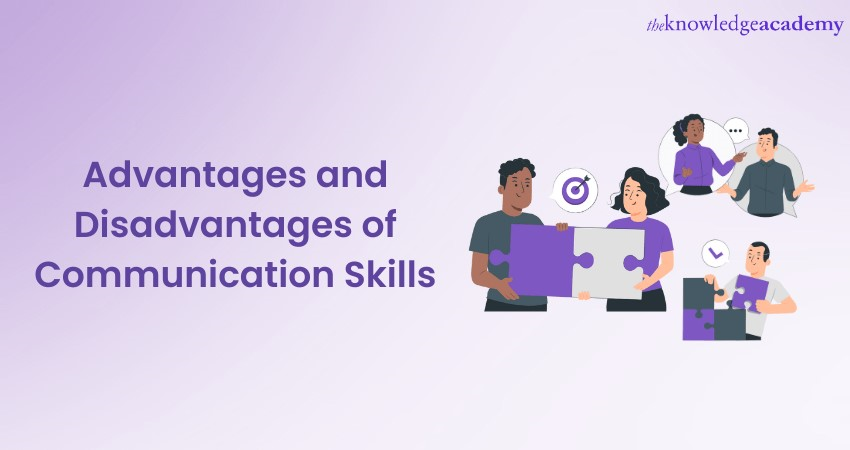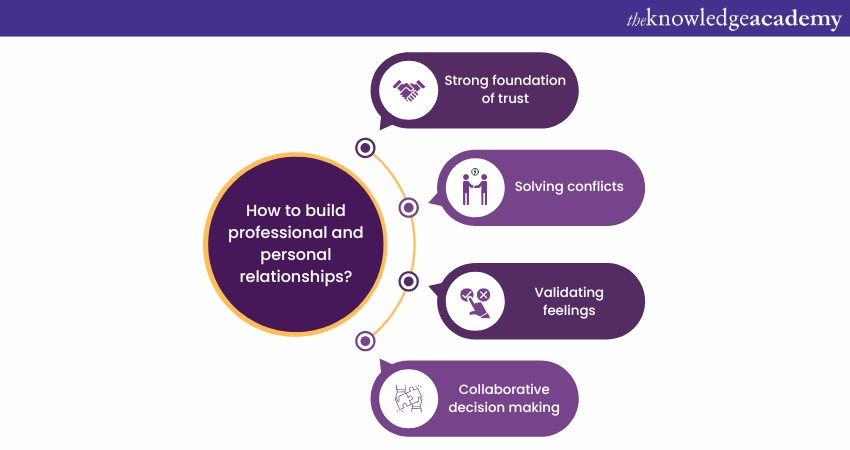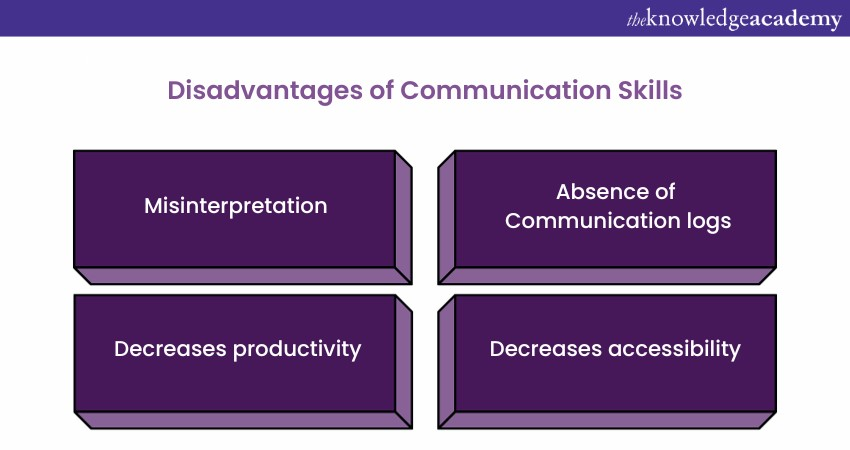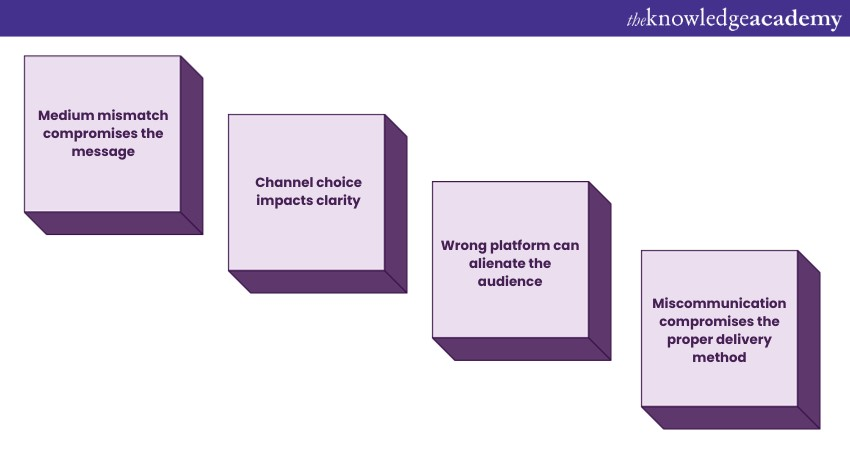We may not have the course you’re looking for. If you enquire or give us a call on 01344203999 and speak to our training experts, we may still be able to help with your training requirements.
Training Outcomes Within Your Budget!
We ensure quality, budget-alignment, and timely delivery by our expert instructors.

Communication Skills are fundamental to human interactions, shaping the way we understand and are understood by others. However, there are Advantages and Disadvantages of Communication Skills, both in personal and professional settings, if not approached properly.
Communication Skills can bridge gaps, foster understanding, and build trust. However, it can also become a source of confusion and conflict. Want to know how? Read this blog to learn everything about the Advantages and Disadvantages of Communication Skills. Read ahead to learn more!
Table of Contents
1) Advantages of Communication Skills
a) Building strong relationships
b) Enhancing professional growth
c) Facilitating problem solving
d) Ensuring clear understanding
e) Boosting self-confidence
2) Disadvantages of Communication Skills
a) Risks caused due to misinterpretation
b) Over-reliance on verbal communication
c) Potentially overwhelming amount of information
d) Incorrect medium choice
e) Breeding conflicts
3) Conclusion
Advantages of Communication Skills
After learning about What are Communication Skills, it’s time to learn about the advantages of Communication Skills. These advantages are as follows:
Building strong relationships
One of the most important aspects of having good Communication Skills are to build meaningful professional and personal relationships. You can understand more about them by going through these components:

1) Foundation of trust: Effective communication fosters transparency and honesty. It is an essential element for building trust in any relationship.
2) Deepened understanding: Regular and open dialogue allows individuals to understand each other's perspectives, emotions, and motivations, leading to deeper connections.
3) Conflict resolution: Good Communication Skills are crucial for addressing and resolving misunderstandings or disagreements, preventing them from escalating into larger issues.
4) Shared experiences: Communicating allows individuals to share personal experiences, creating shared memories and strengthening bonds.
5) Validation of feelings: By expressing and acknowledging emotions, individuals validate each other's feelings, promoting mutual respect and empathy.
6) Collaborative decision-making: Effective communication encourages participative decision-making where all parties feel heard and valued.
7) Setting and respecting boundaries: Clearly communicating one's boundaries and understanding those of others ensures mutual respect and harmony in relationships.
8) Empathetic listening: Active and empathetic listening not only facilitates understanding but also makes individuals feel valued and heard, strengthening relational bonds.
9) Shared goals and aspirations: Discussing future plans and aspirations aligns individuals towards common objectives, reinforcing their connection.
10) Cultural sensitivity: Good Communicators are often sensitive to cultural nuances and differences, promoting inclusivity and respect in diverse relationships.
11) Adaptability: Effective Communicators can adapt their style and tone based on the situation and the individual they're interacting with, ensuring that the relationship remains harmonious.
Enhance your personal and professional interactions with our Communication Skills Training.
Enhancing professional growth
Having good Communication Skills can immensely help you in your professional growth. This is how:
1) Career advancement: Employees with exemplary Communication Skills often stand out, making them prime candidates for promotions and leadership roles.
2) Networking opportunities: Effective Communicators can build and maintain extensive professional networks, opening doors to new opportunities and collaborations.
3) Efficient team collaboration: Clear communication ensures team members understand roles, responsibilities, and project goals, leading to enhanced productivity and fewer mistakes.
4) Building credibility: Clear and concise communication can establish an individual's reputation as reliable and knowledgeable, fostering trust among colleagues and superiors.
5) Effective problem-solving: Good Communicators can articulate challenges and facilitate discussions, leading to quicker resolutions and innovative solutions.
6) Influential presentations: The ability to present ideas persuasively can drive change, secure funding, or initiate new projects within an organisation.
7) Client relationships: Clear and empathetic communication is key to understanding client needs, ensuring customer satisfaction, and fostering long-term business relationships.
8) Feedback reception: Those skilled in communication are typically more receptive to feedback, viewing it as an avenue for growth rather than criticism.
9) Negotiation skills: Effective Communicators have an edge in negotiations. They are able to articulate their standpoints clearly and understand the positions of others.
10) Professional development: Regularly participating in discussions, meetings, and conferences not only enhances visibility but also contributes to continuous learning.
11) Cross-departmental collaboration: Good Communicators often bridge gaps between departments, ensuring that projects run smoothly and organisational goals are achieved cohesively.
12) Embracing digital communication: Leveraging communication tools and platforms effectively can further enhance collaboration and information dissemination.
Facilitating problem solving
Effective Communication Skills help you to solve problems both in your personal and professional life. This is how you can use your skills for problem-solving:
1) Identification of issues: Clear communication allows team members to articulate challenges, ensuring that everyone understands the problem's root cause.
2) Collaborative solutions: Open dialogues foster brainstorming sessions where diverse perspectives converge, leading to innovative solutions.
3) Mitigation of conflicts: Effective communication helps address misunderstandings, preventing them from escalating into major disputes.
4) Decision-making process: Engaging in constructive discussions aids in weighing pros and cons, ensuring well-informed decisions.
5) Feedback loop: A continuous communication channel ensures feedback is received, processed, and acted upon, refining solutions further.
6) Stakeholder alignment: Clear communication ensures that all stakeholders, from team members to management, are aligned with the proposed solutions.
7) Documentation: Properly documenting discussions and decisions aids in creating a reference point, ensuring consistency in approach and understanding.
8) Resource allocation: Communicating the nature and scope of problems can help in the appropriate allocation of resources for resolution.
9) Transparency: Open communication fosters a transparent environment where challenges are openly discussed without fear of retribution.
10) Emotional quotient: Recognising and addressing emotional concerns alongside logical issues often leads to more comprehensive solutions.
11) Follow-up mechanism: Effective Communicators ensure follow-ups, gauging the efficacy of solutions and making necessary adjustments.
12) Skill development: Regular problem-solving discussions can enhance analytical skills, with communication acting as a medium for knowledge exchange.
Ensuring clear understanding
Communication Skills help you to communicate all ideas and propositions effectively. This is how these skills help you:
1) Elimination of assumptions: Clear communication minimises the chances of people making assumptions, ensuring that everyone is on the same page.
2) Active listening: Active Listening Skill is pivotal in truly understanding the speaker's intent and message, fostering deeper comprehension.
3) Feedback mechanism: Encouraging questions and feedback ensures that any ambiguities are promptly addressed.
4) Visual aids: Using diagrams, charts, or presentations can enhance understanding by appealing to visual learners.
5) Simplicity: Breaking down complex ideas into simpler terms or using analogies can make concepts more graspable.
6) Consistent messaging: Reiterating key points or using repetition ensures that the main ideas are firmly ingrained in the listener's mind.
7) Tailored communication: Adjusting the communication style based on the audience, be it experts or novices, ensures better resonance and understanding.
8) Clarity in writing: In written communication, clarity and organisation are essential in conveying ideas without confusion.
9) Non-verbal cues: Paying attention to body language, facial expressions, and tone can offer insights into the listener's level of understanding and engagement.
10) Contextualisation: Relating information to real-life scenarios or providing relevant examples can anchor understanding.
11) Immediate recap: Summarising the key points at the end of a discussion reinforces understanding and offers a chance for any lingering questions.
Boost your influence and impact – Sign up now in our Effective Communication Skills Course
Boosting self-confidence
Good Communication Skills help you to deliver your ideas effectively. You are greeted with more positive feedback and entrusted with responsibilities. This is how these skills can help you boost your self-confidence:
1) Positive feedback loop: Receiving acknowledgement and appreciation for clear communication can significantly boost self-esteem.
2) Practice and preparation: Regularly practising and preparing for important discussions can build a comfort level, reducing anxiety and boosting confidence.
3) Self-awareness: Reflecting on one's communication style and actively working on improvements enhances self-esteem.
4) Controlled non-verbal signals: Control over body language, like maintaining eye contact and adopting open postures, reinforces a confident image.
5) Empowered decision-making: Clear communication aids in making informed decisions, enhancing self-reliance and confidence in one's choices.
6) Building relationships: Establishing strong interpersonal relationships through communication fosters a sense of belonging and self-worth.
7) Navigating difficult conversations: The ability to handle conflicts or challenging discussions with poise augments self-assuredness.
8) Continuous learning: Regularly updating and refining Communication Skills through training or reading can instil confidence in adapting to various scenarios.
9) Public speaking opportunities: Embracing opportunities to speak in public forums or meetings and receiving positive feedback can significantly elevate confidence levels.
Own the stage with confidence with our Public Speaking Training.
Disadvantages of Communication Skills
Like every skill (if not implemented precisely) can have drawbacks, there are several Disadvantages of Communication Skills as well. Let's have a detailed look at some of them:

Risks caused due to misinterpretation
There are several cons of Communication Skills. Miscommunication can have a lot of potential to create misunderstandings. They can lead to the following:
1) Cultural differences: Varied cultural backgrounds can lead to different interpretations of words, gestures, or expressions.
2) Ambiguity: Using vague or ambiguous language can cause confusion, leading to potential misunderstandings.
3) Over-reliance on digital tools: Text-based digital communication, devoid of vocal tone or facial expressions, can be easily misconstrued.
4) Non-verbal mismatch: Body language or facial expressions that don't align with verbal messages can lead to confusion about true intentions.
5) Technical jargon: Using industry-specific terms with those unfamiliar can cause confusion or misinterpretation.
6) Emotional barriers: Personal biases, prejudices, or emotions can distort the reception of a message.
7) Information overload: Bombarding someone with too much information can lead to key points being overlooked or misinterpreted.
8) Poor listening skills: Not actively listening can result in missing crucial details or misunderstanding the message's essence.
9) Assumptions: Making assumptions about what the other person knows can lead to gaps in understanding.
10) Lack of feedback: Without a feedback mechanism, it's challenging to clarify or correct misunderstandings.
11) medium choice: Choosing the wrong mode of communication (e.g., email for a sensitive topic) can lead to misinterpretations.
Over-reliance on verbal communication
If you only focus on verbal communication, then you might be neglecting the other areas, where verbal communication alone can pose some risks. They can cause the following:
1) Loss of nuance: Without accompanying non-verbal cues, the depth and emotional context of a message can be missed.
2) Distortion risk: Without written documentation, verbal messages can be misremembered or altered over time, leading to distortions.
3) Lack of record: Verbal Communication offers no tangible record, making it challenging to refer back or verify information.
4) Inefficiency: Repeated verbal explanations, due to a lack of visual aids or written documents can be time-consuming and redundant.
5) Inefficiency: Repeated verbal explanations, due to a lack of visual aids or written documents, can be time-consuming and redundant.
6) Ambiguity: The absence of visual cues or written context might lead to misunderstandings or vague interpretations.
7) Noise interference: External noises or disturbances can distort or drown out verbal messages, causing miscommunication.
8) Dependency on memory: Relying solely on memory after verbal communication can lead to forgetting key details or inaccuracies.
9) Limited outreach: Verbal communication might not be effective for communicating with a larger group simultaneously, unlike written or digital mediums.
10) Absence of time to reflect: Instant verbal interactions might not give recipients ample time to process information or form thoughtful responses.
11) Potential for emotional misreads: Without written clarity, the emotional tone of a verbal message can be misinterpreted, leading to unnecessary conflicts.
12) Lack of accessibility: For those with hearing impairments or language barriers, sole reliance on verbal communication can be exclusive and limiting.
Improve your connections and interactions with our Communication and Interpersonal Skills Course.
Potentially overwhelming amount of information
Communicating several pieces of information can create problems. This is how miscommunication can lead to misunderstandings:
1) Information fatigue: Continuous exposure to excessive data can lead to fatigue, making individuals more prone to overlook crucial details.
2) Dilution of the main message: With an abundance of information, the primary message's significance might get diluted and lost among less relevant details.
3) Stress induction: Feeling pressured to absorb and understand excessive data can induce stress, affecting overall well-being.
4) Decision-making delays: If confronted with too many details, individuals might procrastinate or delay decision-making.
5) Decreased productivity: Sifting through an overabundance of information can consume valuable time, hindering task efficiency.
6) Analysis paralysis: Overthinking due to excessive data can halt action, leading to stagnation in projects or decision-making.
7) Reduced information retention: When bombarded with too much at once, the brain might not retain essential details effectively.
8) Impaired judgment: With overwhelming information, individuals might struggle to discern what's critical, potentially impairing judgment.
9) Avoidance behaviour: To escape the constant barrage of information, individuals might start avoiding certain communication channels or sources.
10) Loss of credibility: Consistently overloading recipients with information might be seen as lacking discernment or clarity, leading to diminished trust.
11) Ineffective collaboration: In team settings, overwhelming data can lead to misalignment as members struggle to align their understandings and actions.
Incorrect medium choice
You need to know the correct medium of communication for different situations. Otherwise, they tend to cause the following:

1) Loss of nuance: Some mediums can't convey the depth or emotion of a message, leading to misinterpretation or reduced impact.
2) Delay in feedback: Choosing a medium with asynchronous communication, like emails, can lead to delays in response, impacting real-time decision-making.
3) Reduced engagement: Some mediums may not be engaging enough for the audience, causing a loss of interest or attention.
4) Confidentiality issues: Unsuitable mediums might expose sensitive information to unauthorised individuals, leading to data breaches.
5) Decreased accessibility: Not everyone has access to or familiarity with all mediums. Choosing an inaccessible medium can alienate parts of your audience.
6) Impersonal nature: Relying solely on text-based mediums might come across as impersonal, missing the warmth of face-to-face or voice-based communication.
7) Over-complication: Using a complex medium for a simple message can lead to confusion and complications.
8) Increased costs: Some communication channels, especially advanced technological platforms, can incur additional costs.
9) Technical failures: Dependence on tech-based mediums comes with risks of technical glitches, leading to communication breakdowns.
10) Misalignment with content: Some messages, like detailed presentations, require visual aids, making purely verbal mediums ineffective.
11) Lack of record: Oral communication doesn't offer a tangible record, unlike written mediums, making it challenging to verify or revisit discussions.
12) Audience size limitations: Some mediums are not suitable for large audiences, making mass communication challenging.
Breeding conflicts
Communication can sometimes lead to a lot of misinformation spread quickly. As a result, it can cause the following:
1) Misinterpretations: When messages are not clear, recipients may understand them differently, leading to disagreements and misunderstandings.
2) Cultural missteps: In diverse settings, a failure to consider cultural norms and values can inadvertently offend or alienate, fuelling conflicts.
3) Decreased trust: Consistent communication failures can erode trust between parties, making future interactions strained.
4) Reactive responses: Misunderstood messages might elicit emotional reactions, leading to knee-jerk responses or retaliation.
5) Hampered productivity: Conflicts often distract from primary tasks, leading to decreased efficiency and focus.
6) Creation of cliques: Prolonged communication problems can lead to the formation of groups or cliques, further deepening divisions.
7) Reduced morale: Constant misunderstandings and disagreements can demotivate individuals, reducing enthusiasm and commitment.
8) Avoidance behaviour: Some might start avoiding interactions altogether to sidestep potential conflicts, hindering collaborative efforts.
9) Escalation: Minor misunderstandings, when not addressed promptly, can escalate into larger issues, consuming more time and resources.
10) Loss of opportunities: Conflicts often delay decisions, leading to missed opportunities in competitive environments.
11) Stunted growth: In the long run, continuous conflicts can hamper the growth and development of teams or organisations.
12) Compromised reputation: Frequent internal or external conflicts can damage an organisation’s reputation, impacting stakeholder trust and loyalty.
Sharpen your business dialogue with our Business Communication Training.
Conclusion
Effective Communication Skills are indispensable, fostering understanding, collaboration, and growth. While they present numerous Advantages and Disadvantages of Communication Skills, a striking balance between them can refine these skills and ensure optimal personal and professional interactions.
Unlock fluency and confidence – Register now in our Spoken English Training.
Frequently Asked Questions
Upcoming Business Skills Resources Batches & Dates
Date
 Effective Communication Skills
Effective Communication Skills
Fri 17th May 2024
Fri 14th Jun 2024
Fri 12th Jul 2024
Fri 16th Aug 2024
Fri 13th Sep 2024
Fri 11th Oct 2024
Fri 15th Nov 2024
Fri 13th Dec 2024







 Top Rated Course
Top Rated Course



 If you wish to make any changes to your course, please
If you wish to make any changes to your course, please


